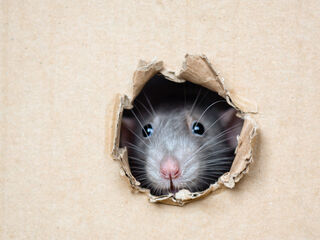Play
What Tickling Rats Tells Us About Human Development
We evolved not just as social mammals, but playful mammals.
Posted September 9, 2022 Reviewed by Tyler Woods
Key points
- All social mammals play, and it is critical for healthy social development.
- Animal research shows us that laughter, joy, and cooperation may have evolved out of play.
- Morality emerges early in development through playing with others and developing a mutual sense of fairness.
On a temperate, controlled laboratory-environment day in the late 1990s, Jaak Panksepp, one of the pioneers of affective neuroscience, puts on his lab coat and gets to work. He is not conducting brain scans, but rather, conducting “vigorous manual stimulation of the ventral body surface” of a rat (Panksepp & Burgdorf, 1999). This is science-speak for, “I tickled the rat’s belly with my finger.” He takes out his recording device and notes the “50 kHz ultrasonic vocalizations as indices of positive affect” (Panksepp & Burgdorf, 2000). This is science-speak for “the rats laugh when I tickle them.”
Believe it or not, this was groundbreaking scientific research.

Laughter and Play in Rats
Rats, like primates, make various sounds associated with specific behaviors or emotions. They scream when they are scared, they laugh when they play, and they vocalize during sex (Knutson et al., 2002). It's all silent to us, however: rats vocalize ultrasonically, outside the range of what human ears can detect. We did not know this until the 1960s, when clever scientists using ultrasonic recording devices to study insects decided to use them on small mammals, too (Pye & Flinn, 1964; Sewell, 1967).
Rats not only like to laugh and be tickled, but to wrestle during play. Panksepp (1981) studied this phenomenon scientifically, through the observational coding of “pinning” in rats, the “usually improbable posture of having their dorsal surface to the ground, with another animal hovering above in a ‘dominance’ stance.”
The Evolution of Play
This research was a big deal because it shows that play, laughter, and joy, are evolutionarily ancient behaviors and emotions in mammals (Panksepp & Burgdorf, 2003). We’ve known for a long time that primates laugh and play like humans do (Loizos, 1967). Humans and chimpanzees, however, diverged on the evolutionary tree about six million years ago, whereas humans and rats diverged about ninety-six million years ago (Nei et al., 2001).
Play is a developmentally critical phenomenon in humans and these findings indicate that this has been the case in mammals since at least the age of the dinosaurs.
Play Is Critical for Social Development
From an early age, play aids the development of motor skills and musculature in both humans and rats (Byers & Walker, 1995; Trawick-Smith, 2014). Even more important than the effects of physical play, which can be practiced alone, are the effects of social play on social development. These developmental effects, too, are true not only in humans but also in rats.
Just as children possess an inherent drive for social play, especially when cooped up inside for too long, rats deprived of socialization will be more motivated to play, and play for longer when reintroduced to peers (Panksepp & Beatty, 1980). If deprived of socialization for an extended time during critical developmental periods, adolescent rats’ orbitofrontal and medial prefrontal cortices will not develop properly (Bell et al., 2010). Conversely, if these brain regions are lesioned, rats will exhibit aggressive and antisocial behavior, indicating maldevelopment of social cognition (Bell et al., 2009).
Rough-and-tumble play, in particular, is important for children in identifying the limits of their bodies and in learning to self-handicap their strength so as not to cause others pain or harm (Pellegrini, 2002). This function appears to have evolved in rats, too. Rats who are injured by a playmate are much less likely to play again with that particular partner, indicating the necessity of self-handicapping for sustained play (Panksepp et al., 1984).
When rats play-wrestle, the dominant rat will pin the subordinate rat about 70 percent of the time (Panksepp et al., 1984). The dominant rat is usually about 10 percent larger, though, interestingly, this pinning occurs even if the rats are initially the same size. Eventually, one will come out as dominant, and begin to grow (Panksepp et al., 1984).
Despite winning 70 percent of the time, during play (but not during genuine aggression), dominant rats assume postures that make it easier for subordinates to flip them over (Pellis et al., 2005). This self-handicapping is hypothesized to be related to reciprocity, but will not continue if rats are devocalized, suggesting that rats need to communicate to maintain cooperative play (Pellis et al., 2010; Kisko et al., 2015). Moreover, rats with cortical lesions are able to sustain reciprocal play, suggesting that the brain areas involved in these social processes are subcortical and more evolutionarily ancient (Pellis et al., 2010).
Play Makes Us Ethical
These findings indicate that reciprocity of play, famously identified by Jean Piaget (1932) as the central catalyst of children’s moral development, may have first emerged in our earliest mammalian ancestors.
Piaget observed that children began to construct a sense of morality and fairness through shared games. Children around the ages of 5 to 8 learn to play cooperatively and can detect violations of an implicit rule structure, even before the cognitive capacity necessary to explicitly state the rules of a game emerge around the ages of 8 to 12 (Piaget, 1932).
In this sense, though humans are unique in being able to explicitly codify moral laws and rules for cooperative play, constructs of fairness may still exist in animals without such cognitive capacities, even in those as far removed from us as rats. (And certainly in other primates: for a great example of how capuchin monkeys respond to violations of fairness, see this excerpt from Frans de Waal’s TED talk).
This sense of fairness, as well as our social intelligence and our capacity for empathy, joy, and laughter, all have their roots in our more than 96 million-year-old shared lineage of social mammals who engage in reciprocal play. Studying the play behavior of rats, and even tickling them in the name of science, shows us what it means to be human.
References
Bell, H. C., McCaffrey, D. R., Forgie, M. L., Kolb, B., & Pellis, S. M. (2009). The role of the medial prefrontal cortex in the play fighting of rats. Behavioral Neuroscience, 123(6), 1158. https://doi.org/10.1037/a0017617
Bell, H. C., Pellis, S. M., & Kolb, B. (2010). Juvenile peer play experience and the development of the orbitofrontal and medial prefrontal cortices. Behavioral Brain Research, 207, 7-13. https://doi.org/10.1016/j.bbr.2009.09.029
Byers, J. A., & Walker, C. (1995). Refining the motor training hypothesis for the evolution of play. The American Naturalist, 146(1), 25-40.
Kisko, T. M., Euston, D. R., & Pellis, S. M. (2015). Are 50-khz calls used as play signals in the playful interactions of rats? III. The effects of devocalization on play with unfamiliar partners as juveniles and as adults. Behavioral Processes, 113, 113–121. https://doi.org/10.1016/j.beproc.2015.01.016
Knutson, B., Burgdorf, J., & Panksepp, J. (2002). Ultrasonic vocalizations as indices of affective states in rats. Psychological Bulletin, 128(6), 961–977. https://doi.org/10.1037/0033-2909.128.6.961
Loizos, C. (1967). Play Behaviour in Higher Primates: a Review. In D. Morris (Ed.), Primate Ethology (pp. 176–218). AldineTransaction.
Nei, M., Xu, P., & Glazko, G. (2001). Estimation of divergence times from multiprotein sequences for a few mammalian species and several distantly related organisms. Proceedings of the National Academy of Sciences, 98(5), 2497-2502. https://doi.org/10.1073/pnas.051611498
Panksepp, J., & Beatty, W. W. (1980). Social deprivation and play in rats. Behavioral and Neural Biology, 30(2), 197–206. https://doi.org/10.1016/s0163-1047(80)91077-8
Panksepp, J. (1981). The Ontogeny of Play in Rats, Developmental Psychobiology, 14(4). https://doi.org/10.1002/dev.420140405
Panksepp, J., Siviy, S., & Normansell, L. (1984). The psychobiology of play: Theoretical and methodological perspectives. Neuroscience and Biobehavioral Reviews, 8(4), 465–492. https://doi.org/10.1016/0149-7634(84)90005-8
Panksepp, J., & Burgdorf, J. (1999). Laughing Rats? Playful Tickling Arouses High-Frequency Ultrasonic Chirping in Young Rodents. In Hameroff, S., Chalmers, C., & Kazniak, A. (Eds.), Toward a Science of Consciousness III (pp. 231-244). MIT Press.
Panksepp, J., & Burgdorf, J. (2000). 50-kHz chirping (laughter?) in response to conditioned and unconditioned tickle-induced reward in rats: effects of social housing and genetic variables. Behavioral Brain Research, 115(1). https://doi.org/10.1016/S0166-4328(00)00238-2
Panksepp, J., & Burgdorf, J. (2003). “Laughing” rats and the evolutionary antecedents of human joy? Physiology & Behavior, 79(3). https://doi.org/10.1016/S0031-9384(03)00159-8
Pellegrini, A. D. (2002). Rough-and-tumble play from childhood through adolescence: Development and possible functions. In Smith, P. K., & Hart, C. H. (Eds.), Blackwell Handbook of Childhood Social Development (pp. 438-453). Blackwell Publishing.
Pellis, S. M., Pellis, V. C., & Foroud, A. (2005). Play Fighting: Aggression, Affiliation, and the Development of Nuanced Social Skills. In R. E. Tremblay, W. W. Hartup, & J. Archer (Eds.), Developmental Origins of Aggression (pp. 47–62). The Guilford Press.
Pellis, S. M., Pellis, V. C., & Reinhart, C. J. (2010). The Evolution of Social Play. In C. Worthman, P. Plotsky, D. Schechter, & C. Cummings (Eds.), Formative Experiences: The Interaction of Caregiving, Culture, and Developmental Psychobiology (pp. 404-431). Cambridge: Cambridge University Press.
Piaget, J. (1932). The Moral Judgment of the Child.
Pye, J. D., & Flinn, M. (1964). Equipment for detecting animal ultrasound. Ultrasonics, 2(1). https://doi.org/10.1016/0041-624X(64)90334-8
Sewell, G. (1967). Ultrasound in Adult Rodents. Nature 215(512). https://doi.org/10.1038/215512a0
Trawick-Smith, J. (2014). The physical play and motor development of young children: A review of literature and implications for practice. Center for Early Childhood Education, Eastern Connecticut State University.




